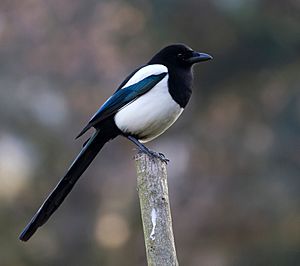Magpie facts for kids
Quick facts for kids Magpie |
|
|---|---|
 |
|
| Eurasian magpie | |
| Scientific classification | |
| Kingdom: | Animalia |
| Phylum: | Chordata |
| Class: | Aves |
| Order: | Passeriformes |
| Superfamily: | Corvoidea |
| Family: | Corvidae |
| Groups included | |
|
|
| Cladistically included but traditionally excluded taxa | |
|
|
Magpies are smart birds that belong to the Corvidae family, which also includes crows and jays. Many people think magpies are very intelligent. For example, the Eurasian magpie is one of the smartest animals in the world. It's even one of the few non-mammals that can recognize itself in a mirror test!
Magpies are known for being able to make and use tools. They can also copy human speech, show sadness, play games, and work together in groups. They have beautiful songs and were once popular as pet birds. Besides the Pica group, other birds called magpies are found in the Cissa, Urocissa, and Cyanopica groups.
Magpies from the Pica group usually live in cooler parts of Europe, Asia, and western North America. You can also find them in Tibet and high mountains in Kashmir. Cyanopica magpies live in East Asia and the Iberian Peninsula (Spain and Portugal). It's important to know that the birds called magpies in Australia are not related to the magpies found in other parts of the world.
Contents
What's in a Name?
Long ago, people in Old English called this bird a "pie." This name came from the Latin word pica. Over time, people started adding "maggie" or "mag" to "pie," which eventually became "magpie."
The word "pica" is also used for a human condition where someone wants to eat things that aren't food. This name comes from the magpie's Latin name, pica, because magpies are known for eating many different kinds of things.
Magpie Families and Types
Even though we call many birds "magpies," they don't all come from the same direct family line. Scientists have found that some magpies have developed long or short tails on their own, not because they are closely related.
There seem to be two main groups of traditional magpies:
- One group includes the black and white magpies from cooler northern parts of the world (like Europe and North America). These are probably related to crows and Eurasian jays.
- The other group has several colorful species from South and East Asia, which are mostly green or blue.
For example, the azure-winged magpie and the Iberian magpie were once thought to be the same species. But now we know they are two different types and are part of the Cyanopica group.
Scientists are still learning about the Pica magpies. Some think that the North American and Korean magpies might be different species from the other Eurasian ones. Or, it's possible that all of them are just one single species, Pica pica.
Oriental (Blue and Green) Magpies
- Subfamily Cissinae
- Genus Urocissa
- Taiwan blue magpie, Urocissa caerulea
- Red-billed blue magpie, Urocissa erythroryncha
- Yellow-billed blue magpie, Urocissa flavirostris
- White-winged magpie, Urocissa whiteheadi
- Sri Lanka blue magpie, Urocissa ornata
- Genus Cissa
- Common green magpie, Cissa chinensis
- Indochinese green magpie, Cissa hypoleuca
- Javan green magpie, Cissa thalassina
- Bornean green magpie, Cissa jefferyi
- Genus Urocissa
Azure-Winged Magpies
- Genus Cyanopica
- Azure-winged magpie, Cyanopica cyanus
- Iberian magpie, Cyanopica cooki
Black and White Magpies
- Genus Pica
- Eurasian magpie, Pica pica
- Black-billed magpie, Pica hudsonia (might be the same species as P. pica)
- Yellow-billed magpie, Pica nuttalli (might be the same species as P. (pica) hudsonia)
- Asir magpie, Pica asirensis (might be the same species as P. pica)
- Maghreb magpie, Pica mauritanica (might be the same species as P. pica)
- Oriental magpie, Pica serica (might be the same species as P. pica)
- Black-rumped magpie. Pica bottanensis (might be the same species as P. pica)
Other Birds Called "Magpies"
Some birds are called "magpies" but are not true magpies from the Corvidae family.
- The black magpies, Platysmurus, are actually treepies. They look similar to magpies but are a different group of birds.
- The Australian magpie, Cracticus tibicen, has black and white feathers like a Eurasian magpie. However, it belongs to the Artamidae family, not the Corvidae family.
- The magpie-robins, from the Copsychus group, also have black and white colors. But they are Old World flycatchers, which are not related to magpies at all.
Magpies and People
Magpies as Pests
In some places, magpies can be a problem for fruit farms. They sometimes eat fruit from orchards.
Magpies in Stories and Traditions
- Magpies are the National bird of Bangladesh.
- In England, people traditionally believed that seeing magpies could predict good or bad luck. It depended on how many magpies you saw! A famous English nursery rhyme called "One for Sorrow" talks about this belief:
One for sorrow,
Two for joy,
Three for a girl,
Four for a boy,
Five for silver,
Six for gold,
Seven for a secret never to be told.
An English historian named John Brand wrote down the first known version of this rhyme in 1780. His version only had four lines: "One for sorrow, Two for mirth, Three for a funeral, And four for a birth."
Later, in 1846, more lines were added to the rhyme.
Sir Humphry Davy, a scientist, explained why seeing one or two magpies might be linked to joy and sorrow. He wrote in 1828 that if the weather is cold, only one magpie might leave the nest to find food, while the other stays with the eggs. But if the weather is warm and nice, both magpies might go out together.
- In sports, some teams that wear black and white striped uniforms are nicknamed "the magpies." Examples include Newcastle United and Notts County from England.
Gallery
Related Pages





